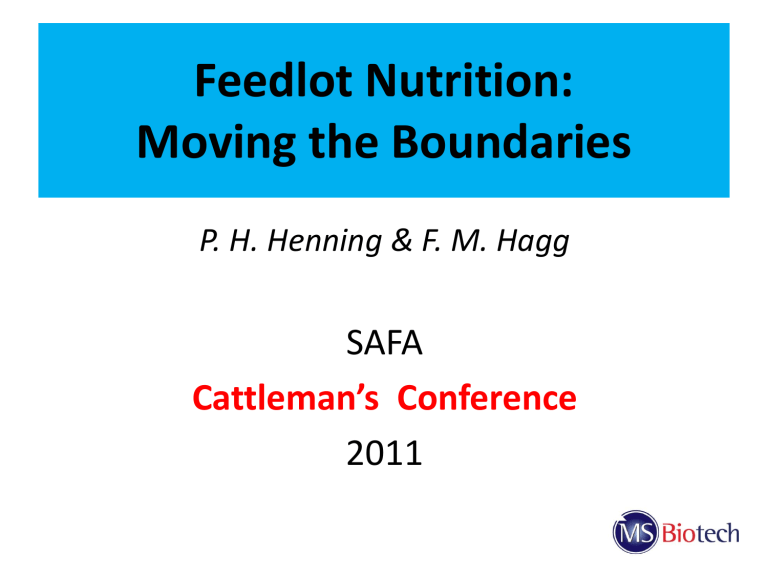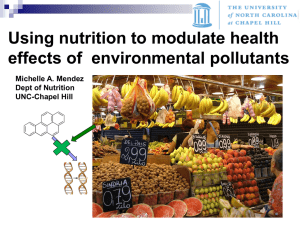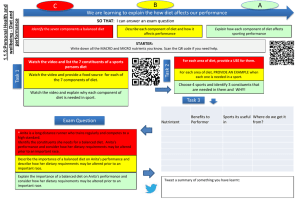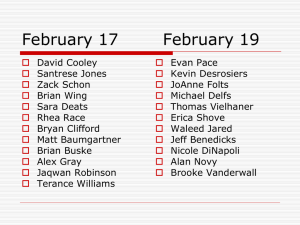Feedlot Nutrition: Moving the Boundaries

Feedlot Nutrition:
Moving the Boundaries
P. H. Henning & F. M. Hagg
SAFA
Cattleman’s Conference
2011
Feedlot Nutrition: Moving the Boundaries
• Introduction
• The boundaries
• Dietary adaptation (step-up)
• Promising new technology
• Parting thoughts
Introduction (1)
“Change is the only certainty”
Introduction (2)
• Changing numbers
– human population ↑
– food / beef requirement ↑
– agricultural land ↓
• Changing views (consumer)
– global village; competitiveness
– sustainability
– animal welfare
– natural / organic
Introduction (3)
• “For the Feedlot Industry change is not a choice but a matter of survival”
• Initiative rather than defensive
• Need to move boundaries
– 4-minute mile
The boundaries (1)
• Feedlot objectives
– produce desired carcass in most cost-effective manner
– maximize carcass weight per unit feedlot (people, facilities, overheads)
– maximize price / value per kg carcass
• FCR (F:G)
• Feed cost per kg gain
The boundaries (2)
• Elements of production
– genetic material
– health care
– management
– nutrition
• ionophores
• DFM’s
• micro-nutrients
• beta-agonists
The boundaries (3)
• Where nutritional boundaries may be challenged and moved:
– lower roughage levels in finishing diets
– NIR to segregate feed ingredients
– grain processing
– energy synchronization with implant payout
– dietary adaptation (step-up)
Dietary adaptation (1)
• Definition: Gradual (sequential) increase in diet grain concentration, over 2 to 4 week period
• USA
65 → 94% concentrate in 28d
• SA
80 → 92% concentrate in 14d
• Substantial variation !!!
Dietary adaptation (2)
• Elements of adaptation
– microbiological change
– physiological change
– behavioral change
• Change in rumen microbial population is the rate-limiting step ?!
Dietary adaptation (3)
• Change from high-forage to high-concentrate diets → marked changes in rumen environment
– rapidly fermentable carbohydrate (RFC) ↑
– fibrolytic bacteria ↓
– amylolytic bacteria ↑
– pH ↓
• Time is required to establish a stable microbial population
Dietary adaptation (4)
• Typical step-up strategies
– sequential (concentrate ↑, roughage ↓)
– restricted feeding of finishing diet
– limited maximum feeding of step-up diets
– Two-diet blending
• starter-finisher
Dietary adaptation (5)
• Go too fast → acidosis
• Most cattle can be rapidly adapted to highgrain diets in few incremental steps.
Minimizing acidosis in the most susceptible individuals, however, requires decreasing the pace of grain adaptation for the entire group
(Bevans et al, 2005)
• This is the essence of current practice
• A boundary begging to be moved
Dietary adaptation (6)
• Implications of dietary adaptation
– higher roughage use
• manure ↑
• methane ↑
• handling ↑
• risk ↑
– delay of desired high energy intake
Promising new technology (1)
• Dietary adaptation = change in rumen microbial population
– Megasphaera elsdenii – key lactic acid utilizer
– numbers low on high roughage diets
– slow growing → requires time to reach adequate levels in rumen
Promising new technology (2)
• Postulated (1975) to use M. elsdenii as DFM to facilitate adaptation
• Thwarted by
– loss of viability during freeze-drying
– sensitivity to oxygen (strict anaerobe)
Promising new technology (3)
• Concept received new impetus with isolation of M. elsdenii NCIMB 41125
– fast-growing
– wide pH optimum
– tolerant of ionophores and in-feed antibiotics
– novel approach to its application
Megasphaera elsdenii NCIMB 41125
Promising new technology (4)
• Novel application
– give live M. elsdenii as a single oral dose to cattle on the first day of the adaptation period
• Hypothesis 1: live M. elsdenii, given as a single oral dose, will:
– rapidly colonise in the rumen
– prevent accumulation of lactic acid
– improve rumen pH
Promising new technology (5)
• Trials to test hypothesis
– rumen-fistulated cattle / sheep
– changed from high-roughage to high-concentrate diet
– given single oral dose of M. elsdenii NCIMB 41125 to coincide with diet change
– ca ≥10 IO viable cells per animal
– McDaniel et al (2008a,b); Henning et al (2010);
Aikman et al (2011)
Promising new technology (6)
P < 0.05
Promising new technology (7)
P < 0.05
Promising new technology (8)
P < 0.05
Rumen pH
7
6.5
6
5.5
Animals fed
5
08:45 10:45 12:45 14:45
Animals fed
16:45 18:45 20:45
Time
Placebo
NCIMB 41125
P<0.1 at this time point
22:45 00:45 02:45 04:45 06:45
Promising new technology (9)
• Hypothesis 2: Live M. elsdenii, given as a single oral dose at start of concentrate feeding, will allow more rapid step-up
• Trials to test hypothesis
– Kansas State University (Thompson et al, 2010)
– ARC-Irene (Henning et al, 2009)
KSU trial
• Objective:
– To evaluate the effect of a single oral dose of
Megasphaera elsdenii NCIMB 41125 on performance of cattle fed either a traditional or an accelerated diet step-up regime
• The study was conducted as a 2 x 2 factorial design with dietary step-up rate (traditional or accelerated) and addition of M. elsdenii or placebo as treatment factors
Dietary treatments
Diet
55% concentrate/45% roughage
65% concentrate/35% roughage
75% concentrate/25% roughage
85% concentrate/15% roughage
94% concentrate/6% roughage
No Tylan included
Traditional 5-step Accelerated 3-step
Days 1 to 4
Days 5 to 8
Days 9 to 12
Days 13 to 16
Days 17 to 95
Days 1 to 3
---
Days 4 to 7
---
Days 8 to 95
Experimental
• 80 crossbred beef cattle
• Animals were kept in individual pens
• 95-day experimental period
• Me-treated animals received a single oral dose of M. elsdenii NCIMB 41125 (10 11 viable cells) on Day 1 (first day of step-up) whilst each control animal received a placebo
Item
No of head
Start LW (kg)
FCR (kg DM / kg LW)
Carcass weight (kg)
(P < 0.10)
Liver abscess (%)
Results
5 – step (16d) 3 – step (7d)
Control Me-treated Control Me-treated
20 20 20 20
408
4.82
334
408
4.53
338
408
4.75
324
408
4.74
335
4.7
5.5
20.1
9.7
ARC-Irene trial
• Hypothesis: Orally dosing cattle with M.
elsdenii at start of feeding period will allow them to go onto the top diet sooner
• Objective: To determine how rapid newlyarrived feedlot cattle may be stepped-up when they are orally dosed with M. elsdenii
• Approach: followed a regression approach with 6 step-up rates, increasing with equal increments
Dietary treatments with different starting roughage levels (% of DM) and subsequent different number of days required to reach the Top Diet containing 5% roughage.
Treatment number
1
2
3
4
5
6
Starting roughage level on Day 1
17.5
15.0
12.5
10.0
7.5
5.0
Roughage level of
Top Diet
5.0
5.0
5.0
5.0
5.0
5.0
Day reaching Top
Diet
21
17
13
9
5
1
Ingredient composition (% A-F) of the basal diets used in the trial.
Ingredient
Eragrostis curvula hay
Ground maize (corn)
Wheat bran
Commercial HPC
Molasses meal
Feed lime
Salt
Urea
Vit-min premix
Starter
17.5
56.4
10.0
8.5
5.0
1.0
0.5
1.0
0.1
Grower
5.0
73.4
6.0
8.0
5.0
1.0
0.5
1.0
0.1
Nutrient composition of the experimental diets (%DM).
Nutrients
CP
Starch
NDF
ADF
EE
ME (MJ/kg DM)(calculated)
Starter
14.7
40.8
30.2
16.6
3.4
11.1
Grower
14.6
52.0
19.8
9.9
3.4
12.1
Experimental
• 36 Bonsmara steers (W = 231 ± 9.9 kg)
• No previous exposure to concentrate diets
• Kept in single pens
• Fed ad libitum at 08:00 and 15:00
• Roughage for 2 weeks, fast for 18h, feeding of experimental diets from Day 1 to Day 35
• 100 ml oral dose of M. elsdenii NCIMB 41125
(10 11 cfu) at 08:00 on Day 1, just prior to feeding concentrate diets for the first time
The effect of diet step-up rate on performance (Days 1 to 35) of feedlot steers receiving a single oral dose of M. elsdenii.
DMI (kg/d)
21
4.94
Day reaching Top Diet
17 13 9 5 1
5.19
5.07
4.43
5.43
5.32
ADG (kg/d)
FCR 1
No. of pulls 2
1.04
5.25
1
1.05
5.23
0
1.21
4.31
1
1.27
3.54
1
1.14
4.91
1
1 Feed conversion ratio
2 Animals showing symptoms of digestive or respiratory health problems
1.25
4.28
1
Regression
P-value
0.57
0.09
0.28
.
DMI Day 1 - 35
6
5,5
5
4,5
4
3,5
3
2,5
2
21 17 13 9
Day reaching Top Diet
5 1
ADG Day 1 - 35
0,7
0,6
0,5
0,4
1
0,9
0,8
1,4
1,3
1,2
1,1
21 y = 0.0394x + 1.022
R² = 0.5485
P = 0.09
17 13 9
Day reaching Top Diet
5 1
FCR Day 1 - 35
6
5,5
5
4,5
4
3,5
3
2,5
2
21 17 13 9
Day reaching Top Diet
5 1
Fig 7. Total roughage intake (Day 1-35) (kg DM/steer)
16
14
12
10
8
6
4
2
0
21 y = -0.9514x + 14.013
R² = 0.7178
P = 0.03
17 13 9
Day reaching Top Diet
5 1
Conclusions
1. In cattle dosed with M. elsdenii it was possible to increase step-up rate, without compromising performance
2. Higher energy intake plus M. elsdenii benefitted performance
3. Increasing step-up rate reduced the need for roughage
Promising new technology (10)
• M. elsdenii is a promising tool to move boundaries in feedlot nutrition
• Further trials currently in progress
– large experimental pen trial at KSU
– large-pen commercial feedlot trials
Promising new technology (11)
• Important considerations
– applying M. elsdenii with current step-up = defeating the object; greatest advantage expected when used in conjunction with accelerated stepup
– need to adjust revised starter diet(s) for content of other critical nutrients and therapeutic agents
– concern about early finishing
Parting thoughts
• Awareness of the need to move boundaries, and willingness to try new technologies
• Step-up is a very real boundary, and one which may be moved
• Megasphaera elsdenii is a promising new tool in the hand of the Feedlotter
• As with other tools it requires strategic
application to be beneficial









